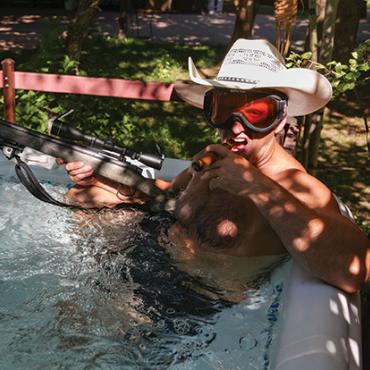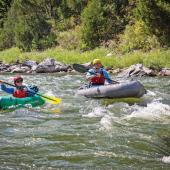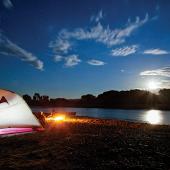Sweet Surrender
Whitewater canoeing in southwest Montana.
From our vantage point a quarter-mile upstream, Doug and I could see the whitecaps: a long lane of foaming whitewater separated from the main surge by a thin strip of land. Several kayakers milled about, taking turns surfing the various waves; one of them spotted us and within seconds a small crowd had gathered to watch the impending carnage. They’d seen plenty of kayaks and rafts roll through the Four Banger rapid, but never a canoe. This should be good, their eager smiles and wide eyes seemed to say.
One of the most turbulent sections of whitewater on the lower Yellowstone, Four Banger is named for the four large and distinct waves that appear and disappear depending on water level. It looked like #2 was in now, and it was a monster—tall and imposing, churning with a violent rage. The last kayaker—a red speck darting across the wave’s frothy face—saw us coming and cleared out, making way for the two fools in a canoe.
In we came, fast and hard. The roiling water slapped us around and we struggled to keep the bow downstream. Water splashed up and over as we plowed through wave after wave. Steering left to avoid a dangerous hydraulic, we quickly angled back to the middle. We would punch the big wave right in the mouth: straight up the pipe, baby; go big or go home.
The crowd cheered as we hit the wave head-on. Up the towering face we rode, the canoe going damn near vertical. I saw Doug’s body go rigid, his head pointed down and his arms frozen in place. “Paddle!” I screamed, but it was no use; the bow was out over the top of the wave and there was nothing but air below him. I felt a sudden shift, a sort of cosmic pause, as if the universe were yawning. And then our world went into reverse.
The canoe shot backward down the face of the wave and for a few brief moments, we were surfing—backward, in an open boat, but surfing nonetheless. Foam exploded all around us. I applied stabilizing strokes as best I could but knew it was only delaying the inevitable. After a few seconds of frantic paddling—and more cheering from the crowd—we went over.
The frigid water shocked us into action. One hand on our paddles, one on the boat, we kicked like mad for the island. But the water was too fast. We missed the downstream point by mere feet and found ourselves suddenly and irretrievably screwed: smack dab in the middle of the roaring Yellowstone, moving at twenty-some-thousand cubic feet per second, a hundred yards of surging meltwater on either side of us.
But fast as the river was, it was also flat. We collected ourselves and, as men naturally do in these situations, broke into assaults on each other’s intelligence and physical abilities.
“Let’s canoe the Yellowstone at flood stage—brilliant idea!”
“If you hadn’t frozen up like a little girl, we’d have made it!”
And so it went, until we were both laughing at our mutual folly and ineptitude. Then we set to work getting to shore. Some twenty minutes and two miles later, we hauled our frozen and fatigued bodies up the bank, collapsing onto the rocks. Hard, bumpy ground never felt so good. And as if to repay our misfortune, the gods had deposited us at a fishermen’s picnic site. We spread our wet clothes on the clothesline, sprawled out on the picnic table, and soaked away our full-body goose bumps in the warm afternoon sun. The Crazy Mountains loomed above the bluffs to the northwest, while a vast and verdant hayfield sprawled out behind us, rolling up toward a distant I-90. Beyond the interstate rose foothill after foothill and finally, the mighty Absarokas. Our spirits restored by this display of grandeur, we ate a quick lunch and launched the boat back into the swollen waters of the Yellowstone River.
Though popular in other parts of the country, whitewater canoeing is a rare, niche activity in southwest Montana. Sure, canoes abound, strapped atop cars and trucks all summer long; but most are used for navigating the clear, calmer waters of lakes and post-runoff rivers. Whitewater canoeing stories, then, tend to be tales of horror and madness: rounding a bend, confronting a deathly wall of whitecaps, and barely coming out alive; or an impulsive, beer- and bravado-induced plunge into Yankee Jim or Beartrap, often ending in disaster. Indeed, few Bozemanites even realize that canoes, like kayaks, have a wide range of styles, and that whitewater canoes employ a specialized design that allows them to navigate whitewater with relative ease. And for the elite and intrepid few who paddle a canoe as their craft of choice, there’s nothing quite like it.
“Canoeing is more challenging,” says Bill Zell, owner of Montana Whitewater, a rafting outfitter on the Gallatin and Yellowstone rivers. Zell’s been running whitewater in a canoe for over two decades, and has logged an impressive open-boat resume: House Rock, the Kitchen Sink, the Boulder River, the Salmon, the Grand Canyon. He’s been dumped, rolled, and tossed about like a riparian rag doll—and he wouldn’t have it any other way. “A canoe is more versatile; you can take it on whitewater, lakes, small streams, whatever.” Zell also likes that he can ride double with his wife Margot, and that a canoe can be loaded down with more gear for longer trips sans support raft. And for him, there’s an inexplicable passion, a distinct and indelible zeal: “It’s the way to go, baby.”
Chris Ennis, a buyer at Northern Lights and a former competitive canoeist, agrees. “I really like the perspective gained on the river,” he says. By kneeling in a canoe, as opposed to sitting flat in a kayak, he can see more features and look much further downstream. “It often saves us from having to stop and scout the river,” he explains. He also notes the physical benefits of canoeing versus kayaking: it’s easier on your back and abs, and you don’t feel as claustrophobic: “It’s a more natural position.”
Though Ennis currently paddles a skirted canoe for easier rolling, he spent much of his life in an open boat and has nothing but respect for canoes. “You can roll them, you can paddle all the same water as a kayak. And being higher up, you have an enormous amount of leverage.” He likens canoeing to telemark skiing—it’s harder than alpine skiing, sure, but for the most part, “a good tele skier can keep up.” In the end, he says, it’s all about preference. “If whitewater’s in your blood and the only way you feel comfortable is kneeling, then by golly that’s what you do.”
After our inadvertent immersion in the Yellowstone, Doug and I turned our attention to the upper Gallatin, where the tight, technical water presented its own set of challenges. Gone were the massive rollers and six-foot standing waves; this water required quick maneuvering and constant vigilance. It was time to sharpen our focus.
We launched at Moose Flat and let the rushing current flush us downstream. At the first rapid, we went over a drop and plowed the bow underwater, swamping the boat. Doug kept the canoe straight while I furiously bailed water. The next rapid slapped us about and nearly tipped us over; only a hard hip-check kept us upright. Still, we were swamped yet again. This time we eddied out, dumped the boat, and gathered our wits for the remainder of the run.
Back into the eye of the storm we went. Despite our increased attention, the raging torrent had its way with us again and again, and we learned the first lesson of whitewater canoeing: the river is in charge. You can’t beat it. If you want to enjoy the experience rather than merely ride it out, you must become a sort of fatalist. Give yourself to the river. Know that you will swim and that you will be scared shitless: that you will feel the tug of primordial terror as you return to the water whence you came. But when you make it to shore—and if you keep a cool head, you will—you’ll feel more alive than ever before.
Which is exactly how we felt, despite being cold, tired, and waterlogged, as we pulled ashore at the Lava Lake trailhead. We had developed a rhythm and were working well together: instinctively predicting each other’s movements, responding to obstacles with the same unspoken intent. We were dialed in. And we were ready to load up the canoe and head for the next river, the next adventure, the next challenge. We knew it may take a lifetime to run all the rapids we wanted to, and that we had a lot to learn about whitewater. But as we clinked PBR cans at the takeout, we also knew that like the sea-bound water flowing before us, we had all the time in the world to get there.















